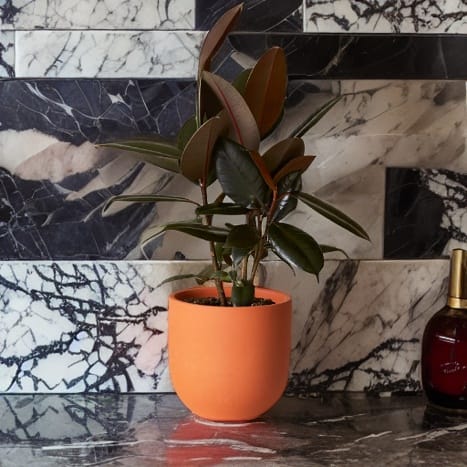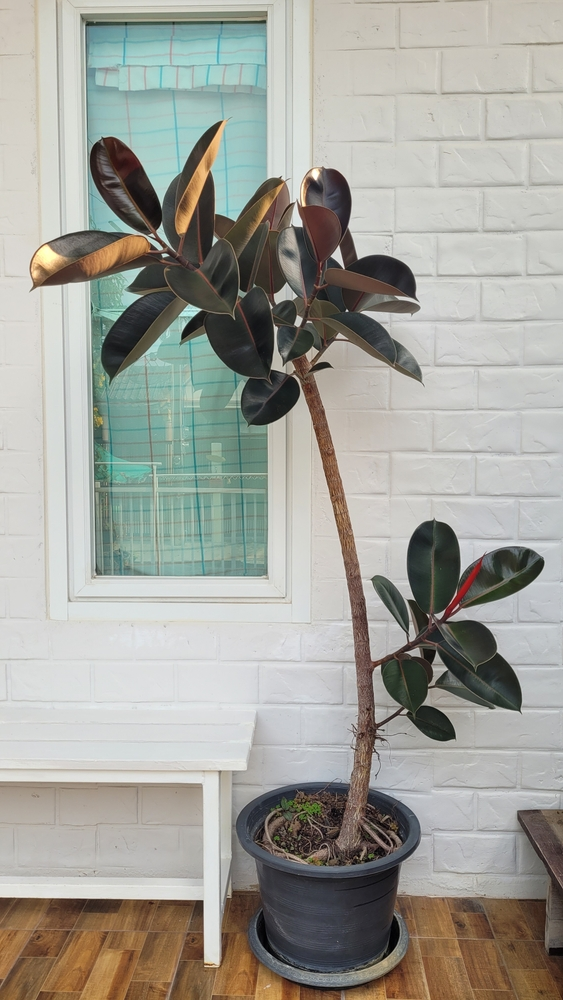HousePlantJoy is supported by our audience. When you purchase through one of our links, we may earn a small affiliate commission. As an Amazon Associate I earn from qualifying purchases. Your cost is not affected.
==================
Embarking on the journey of cultivating a Burgundy Rubber Tree? This guide covers everything, from its Southeast Asian origins to care tips, common issues, and propagation. Ready to cultivate tropical elegance? Happy gardening!
Mastering the Art of Growing a Burgundy Rubber Tree
Greetings, green thumb enthusiast! Have you ever considered the addition of a burgundy rubber tree to your indoor plant collection? Known for its striking, deep red leaves and grandeur, this plant can infuse a unique appeal into your living space.
Burgundy Rubber Tree
The burgundy rubber tree, scientifically known as Ficus elastica ‘Burgundy’, is a variety of the rubber tree plant. This robust plant often grows to towering heights in its natural habitat. But it remains more modestly sized when grown indoors.
This beautiful plant is not only a visual treat but is also known for its low maintenance requirements. However, like every other plant, it has its own specific needs to thrive. So, let’s delve deeper into understanding this marvel of nature better.
The History and Origin of the Burgundy Rubber Tree
The burgundy rubber tree is native to Southeast Asia, specifically the regions of India, Bhutan, Nepal, Burma, China, Malaysia, and Indonesia. The plant grows up to 50-100 feet tall in these tropical climates.
Historically, these trees have been a source of natural rubber in many cultures. Additionally, the sap is used to create a latex material. However, the production of rubber from these trees is not commercially viable and has been largely replaced by the Hevea brasiliensis, or the Brazilian rubber tree.
Spectacular Indoor Plant
In the 17th and 18th centuries, the burgundy rubber tree made its way to Europe, where it became a popular ornamental plant, particularly in Victorian-era households. Today, it continues to be a beloved houseplant worldwide, admired for its lush, glossy, and burgundy-hued foliage.
Understanding the Characteristics of a Burgundy Tree
The burgundy rubber tree exhibits a number of distinctive characteristics that set it apart from other indoor plants. The most striking feature is, of course, its leaves. These are large, broad, elliptic, and have a deep burgundy color that can appear almost black in certain lighting conditions.
Ficus Elastica Burgundy Occasionally Flower
The plant grows symmetrically, with new leaves sprouting from the top and developing a protective sheath that falls off as the leaf matures. The burgundy rubber tree also produces small, non-ornamental flowers in its natural habitat, but these are rarely seen when the plant is grown indoors.
This plant’s vertical growth habit makes it an ideal choice for corners of rooms or areas with limited horizontal space. In the right conditions, indoor burgundy rubber trees can reach a height of 6-10 feet.
Comprehensive Guide to Ficus Elastica Burgundy Care
Providing ideal conditions for your burgundy rubber tree ensures its healthy growth. It requires moderate to bright indirect light. If the leaves start losing their burgundy color, it’s a sign that the plant is not getting enough light.
Ample Drainage Holes a Must
Watering must be done cautiously, as overwatering can lead to root rot. The soil should be allowed to dry out a bit between watering. The plant prefers a humid environment, so misting the leaves or placing a tray with water near the plant can help maintain the required humidity.
As for the soil, a well-draining potting mix is essential. A mix of peat, perlite, and pine bark is typically recommended. Feed your burgundy rubber tree with a balanced liquid fertilizer once a month during the growing season.
Top Tips for Growing a Healthy Burgundy Rubber Tree
Regular pruning can keep your burgundy rubber tree in top shape. Pruning encourages bushier growth and prevents the plant from becoming too leggy.
Wiping the leaves with a damp cloth helps remove dust and helps the plant photosynthesize more efficiently.
Accepts Common Indoor Temperatures
While the burgundy rubber tree tolerates a range of temperatures, it prefers a steady climate. Avoid placing it near drafts or sudden temperature changes.
Remember, patience is key. The burgundy rubber tree might take some time to adjust to a new environment. So, don’t be disheartened if it doesn’t show immediate growth.
Common Issues and Solutions in Growing a Burgundy Tree
Like any other plant, the burgundy rubber tree can face some common issues. The yellowing of leaves is usually a sign of overwatering. If the leaf edges begin to turn brown, it indicates a lack of humidity. The rubber plant prefers well-draining soil and requires high humidity.
Watch for Pests
Pests such as mealybugs, spider mites, and scales can attack your plant. Regular inspection and immediate action can prevent severe infestations.
Moreover, if your burgundy rubber tree is not growing as expected, consider checking the light conditions, soil quality, and watering schedule. Adjustments in these areas often resolve the issue.
Toxic or Not?
The rubber plant is considered mildly toxic to humans and animals if ingested or in contact with skin. The plant contains a milky sap that causes intestinal problems, skin irritation, and a burning sensation in the eyes, nose, and mouth.
The toxicity is mild and rarely fatal. But it can be uncomfortable and unpleasant. Rubber plants should be kept away from children and pets who might chew on them.
Video Credit: @onlyplants
Indoor vs Outdoor Growth for the Burgundy Rubber Tree
While the burgundy rubber tree can be grown both indoors and outdoors, its care requirements vary accordingly. Indoor plants need less frequent watering and tolerate lower light conditions compared to those grown outdoors.
Outdoor burgundy rubber trees can grow much larger and require a warmer and more humid environment. Remember, this plant is not frost-tolerant, so it’s best to keep it indoors or move it inside during the winter months in colder climates.
Propagating a Burgundy Rubber Tree
Propagating a burgundy rubber tree can be a rewarding experience. The most common method is stem cutting. Take a 6-8 inch cutting from a healthy plant, let it dry for a few hours to let the sap seal, and then plant it in a well-draining potting mix.
With proper care, the cutting should root in a few weeks. Remember, the key to successful propagation is patience and consistent care.
Best Places to Buy a Burgundy Rubber Tree
Whether you prefer shopping online or visiting a local nursery, there are plenty of places to buy a burgundy rubber tree. Online platforms offer a wide variety of sizes and prices, while local nurseries allow you to handpick your plant.
Before making a purchase, check the plant’s health and the seller’s reputation. A healthy burgundy rubber tree will have vibrant, glossy leaves and show no signs of pests or diseases.
Mastering the Art of Growing a Burgundy Rubber Tree
In conclusion, embarking on the cultivation journey of a burgundy rubber tree is a rewarding endeavor. With devoted care and attention, this remarkable plant has the potential to bring a touch of tropical elegance to your living space. Acknowledging the uniqueness of each plant, remember that flourishing requires time and patience. So, as you continue to nurture your burgundy rubber tree, join us in the ongoing celebration of growth. Happy gardening, and may your green companion thrive into a spectacular display of natural beauty!
Frequently Asked Questions
Where is the burgundy rubber tree native to?
The burgundy rubber tree, scientifically known as Ficus elastica ‘Burgundy,’ is native to Southeast Asia. Its natural habitat includes regions such as India, Bhutan, Nepal, Burma, China, Malaysia, and Indonesia.
How tall can an indoor burgundy rubber tree grow, and what are its ideal growing conditions?
In the right conditions, indoor burgundy rubber trees can reach a height of 6-10 feet. They thrive in moderate to bright indirect light, require well-draining soil, and prefer a humid environment. Adequate watering, careful pruning, and balanced fertilization contribute to their healthy growth.
Is the burgundy rubber tree toxic to humans and pets?
Yes, the burgundy rubber tree is considered mildly toxic. The plant contains a milky sap that can cause intestinal problems, skin irritation, and a burning sensation if ingested or in contact with skin, eyes, nose, or mouth. While the toxicity is generally mild, it’s advisable to keep the plant away from children and pets.
Connect with Us for Green Inspiration! ?
Explore the world of indoor gardening, houseplants, and home design on our social media platforms! ? Follow us on Facebook, Instagram, Pinterest, Twitter, and even catch us on TikTok. Discover engaging content, insightful product reviews, and join a vibrant community passionate about all things green. Let’s grow together! #HouseplantJoy #GreenLiving











